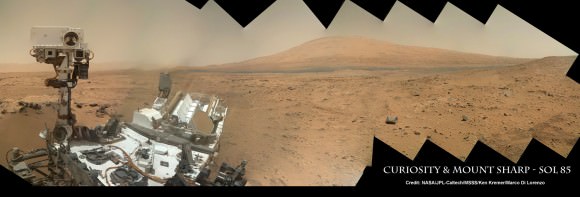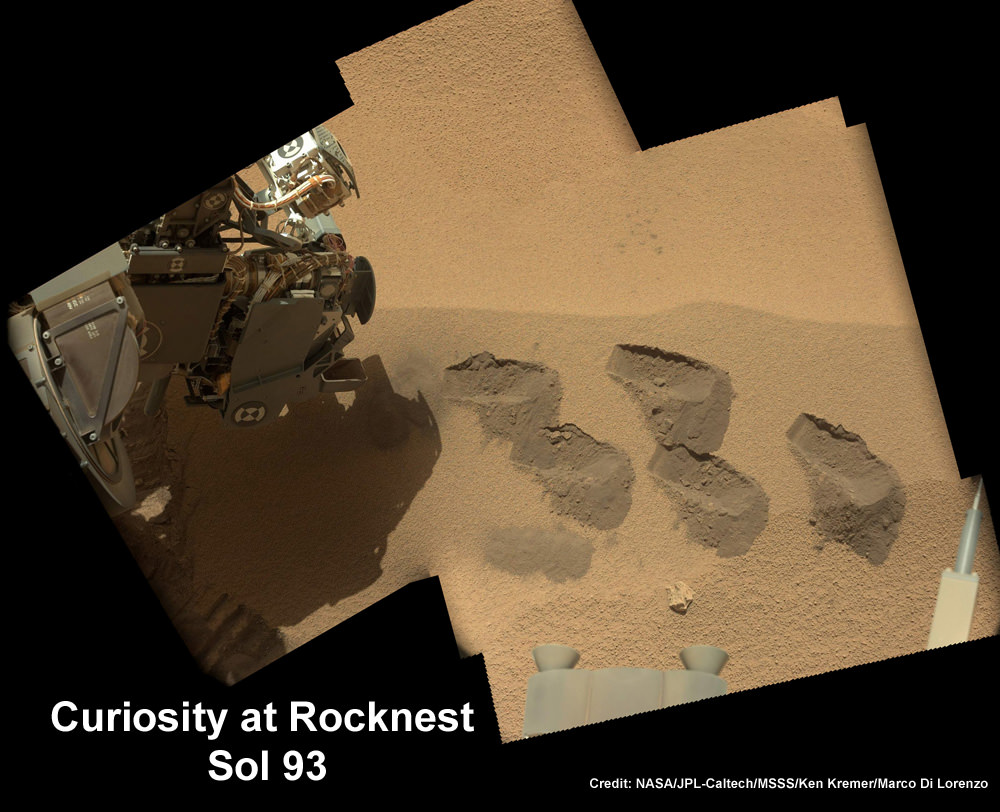Image caption: Curiosity scoops repeatedly into this Martian soil at windblown ripple dubbed ‘Rocknest’, shown in this mosaic, and delivered samples to the SAM chemistry instrument, on the robots deck, to search for any signatures of organic molecules – the building blocks of life. This color mosaic was stitched together from hi-res color images taken by the robots 34 mm Mastcam camera on Sols 93 and 74. Credit: NASA / JPL-Caltech / MSSS/Ken Kremer / Marco Di Lorenzo
Has Curiosity made a ‘Historic’ science discovery with the SAM (Sample Analysis at Mars) chemistry instrument that analyzes Martian soil (see mosaic above) and is designed to detect organic molecules – the building blocks of life? Has Curiosity unambiguously and directly detected the first signatures of organics on Mars ? Is an announcement imminent?
Speculation is rampant that NASA’s Curiosity Mars rover has made an earth-shaking discovery ‘for the history books’ , following a radio interview by NPR’s Joe Palca with the mission’s Principal Investigator, John Grotzinger, while sitting in his office at Caltech last week. NPR reported the story on Tuesday, Nov. 20.
“We’ve got a briefing on Monday [Dec 3] where we’ll discuss our results,” John Grotzinger told me.
Grotzinger will describe the SAM data and their potentially pivotal implications at the annual meeting of the AGU (American Geophysical Union) being held from Dec 3-7 in San Francisco. Many papers and results from the first three months of the Curiosity Mars Science Lab (MSL) mission will be presented at the AGU meeting.
“The science team is analyzing data from SAM’s soil inspection, but not ready to discuss yet,” JPL Press spokesman Guy Webster informed me today.
It’s the Thanksgiving holiday period here in the US so the answers will wait a tad longer.

Image Caption: Curiosity Self Portrait with Mount Sharp at Rocknest ripple in Gale Crater. Curiosity used the Mars Hand Lens Imager (MAHLI) camera on the robotic arm to image herself and her target destination Mount Sharp in the background.SAM chemistry suite located on robot’s deck near Mast. To the left is the northern rim wall of Gale Crater. This color panoramic mosaic was assembled from raw images snapped on Sol 85 (Nov. 1, 2012). Credit: NASA/JPL-Caltech/MSSS/Ken Kremer/Marco Di Lorenzo
Curiosity had been collecting and analyzing Martian soil samples for more than a month at a windblown ripple called ‘Rocknest’. So far Curiosity has scooped into the Martian soil five times and delivered a single sample to SAM and two to the adjacent CheMin chemistry instrument.
“This data is gonna be one for the history books,” Grotzinger went on to say to NPR. “It’s looking really good.”
JPL Press spokesman Guy Webster advises caution and patience while damping down euphoria. He told me that the team is still trying to interpret and understand the analysis from SAM and seeking to clarify their meaning before making any premature conclusions.
“This is no change from the policy with past results from the mission, such as SAM’s atmosphere analysis or CheMin’s soil sample analysis: The scientists want to gain confidence in the findings before taking them outside of the science team,” Webster informed me.
“As for history books, the whole mission is for the history books. John was delighted about the quality and range of information coming in from SAM during the day a reporter happened to be sitting in John’s office last week. He has been similarly delighted by results at other points during the mission so far,” Webster said.
Organic molecules are the basis for life as we know it, and they have never before been discovered on the Red Planet’s surface. I am an organic chemist and to me the detection of organics on Mars would indeed be “Earth-shaking”. But just a finding of organics alone does NOT mean we discovered life. Organics are a prerequisite to life. Life requires finding much more complex molecules, like amino acids and far more beyond that.
Furthermore, finding signatures of organics so close to the surface might be a surprising result when one recalls that highly destructive ionizing radiation bombards the Martian topsoil 24/7.
So, it’s wise for the MSL team to be abundantly cautious and recheck their results multiple times. They wisely waited for further data before prematurely announcing the discovery of Martian methane. Initial SAM atmospheric measurements detecting methane turned out to be false – they actually originated from contamination by residual traces of Florida air trapped in the interior chambers of SAM and were carried all the way to Mars.
If organics are detected in the dusty dunes at Rocknest, the implications could be vast and potentially point to their widespread distribution across Gale crater and beyond.
As renowned astronomer Carl Sagan once said; ‘Extraordinary claims require extraordinary evidence.”
Stay tuned.
Learn more about Curiosity’s groundbreaking discoveries, SAM and NASA missions at my upcoming free public presentations:
-
- on Dec. 6 held at Brookdale Community College, Monmouth Museum, Lincroft, NJ at 8 PM – hosted by STAR astronomy
-
- and on Dec 11 held at Princeton University and the Amateur Astronomers Association of Princeton (AAAP) in Princeton, NJ at 8 PM.
…..
Dec 6: Free Public lecture titled “Atlantis, The Premature End of America’s Shuttle Program and What’s Beyond for NASA” including Curiosity, Orion, SpaceX and more by Ken Kremer at Brookdale Community College/Monmouth Museum and STAR Astronomy club in Lincroft, NJ at 8 PM
Dec 11: Free Public lecture titled “Curiosity and the Search for Life on Mars (in 3 D)” and more by Ken Kremer at Princeton University and the Amateur Astronomers Association of Princeton (AAAP) in Princeton, NJ at 8 PM.


so far Curiosity is good at finding traces of itself on Mars.
No idea what the drum roll is for if they want take their time telling the world of discovering yet another clue of an “alien” vehicle on Mars.
“Speculation is rampant”, lol, I wonder why! This website is turning into People magazine.
I was all calmed down and not expecting much and now this article has made me all giddy again… 😉
My bet is that this is organic chemistry.
LC
Organics have already been found in carbonaceous meteorites, and although newsworthy, that announcement wasn’t earthshaking.
Organics were also discovered in Martian meteorites, but while it now seems that those were likely caused by Earth contamination, again – at first announcement it was newsworthy, but without cartwheels.
Last year’s Martian meteorite fall, Tissint, contains carbon elements within the matrix.
Along with a few lesser points I that I have in mind, I’m not so sure about the discovery of organics being “above the fold” when this discovery is revealed.
To further my dubiousness is that a date in Dec has been picked to give the details.
If this is such a big deal, why not as soon as their “data confirmation” is completed, instead of sitting on it?
A lesson to be learned – not too long ago, US scientists sat secretly on their discovery of a new planetoid (Sedna?) until what they thought would be an optimum moment for release, and they were headline-scooped by another astronomy team that also discovered it after, and announced it right away.
I think Torbjorn might be the one who’s got it right – Chinese whispers.
Maybe, but finding evidence of recent volcanics does not seem to rise to this occasion. The discovery of Sedna did seem to be pretty ground breaking, at least since Tombaugh’s discovery of Pluto. Of course Pluto(oids) are not sort of generic. I suppose we will all have to wait to see what this is.
LC
I hope your are right, but still am lead to suspect that ‘hype’ is key? That is to say, the release of this tantalizing tidbit just prior to the Thanksgiving Holiday shutdown by all gov’t agencies and the coincidental ESA meetings concerning the ExoMars mission are hard to ignore… Bottom line is that they’d better come up with something pertinent, or loose whirledwide interest!
They should hold off until 12/22/12, just for laughs.
That only works in the US and Japan
No, I was playing on the Mayan, End of World, theme. Oh well, it was funny at the time. LOL
doh!
NASA is great at ramping up hype and then not delivering (i.e. organisms that live off of arsenic). I won’t buy into their tactics this time!
On “arsenic life”, NASA wasn’t to blame for the non-delivery, that was the scientists’ failure. They also didn’t hype that arsenic use in nucleotides had meant a wider chemistry for life.
What they did wrong was to hype the scientists themselves, since the science was not the extraordinary evidence needed for the extraordinary claim. In fact, it was quite the opposite as it was sloppy work, and NASA could have caught on to any of that.
Well, it was NASA who was responsible hyping the “discovery” of life that could survive with arsenic, whether they were actually responsible for the discovery is up for debate (I would argue they were). It is not just me who is critical of the hype and failure to deliver sometimes displayed by NASA:
http://www.thestar.com/news/world/article/1292397–mysterious-mars-rover-discovery-draws-alien-hype-critical-backlash
http://www.slate.com/blogs/bad_astronomy/2012/11/21/mars_rover_curiosity_makes_earthshaking_find_no_one_is_talking_but_everyone.html
The results will be icing on the cake I am already amazed!
I had no idea anyone actually listened to NPR?
Here we go again…
NASA: Masters of suspense.
The simple interpretation then is that Grotzinger was excited about the quality of the data, not about any specific result. Good for him, bummer for us in this context, shame for the hyping journalist.
Now this article seems to say something beyond what Webster has injected, but I don’t see what the basis for that is. Of course Grotzinger will present the data that was earlier announced.
– Are we to think that it is Grotzinger that claims they have “potentially pivotal implications”? But the text of the article indicates not.
– Are we to think that the author knows something we do not? But the text of the article indicates not.
This is starting to sound like a round of “chinese whispers”.
7 months of terror.
The only “Earth-shattering” discovery the MSL SAM potentially can make would be the missing organic compounds of the Viking mission. All other data would be “business as usual” and more opportunities for papers to push the careers of NASA affiliated scientists – mostly geologists.
They chose a picture mosaic that looks like as if a Martian dweller had stepped around the rover. Part of the suspense and media show?
No, read the caption.
Scientists should be more careful before shaking the World, after the analysis of the Venera’s itself !
“Mars still has rocks!”
Haven’t we been here before? I seem to remember another “Earthshattering” announcement that was hyped beyond the actual scope of the discovery.
I know NASA needs funding, but geeezzzz….
“Organics are a perquisite to life”
Don’t you mean “prerequisite?” A perquisite would be a fringe benefit.
Spell chequers have a lot to answer four
Cheque mate. For sure, we are under their spell.
There is a lot of cynicism here and I guess rightly so, I can’t help wishing for something stunning though, it would change so many things.
It should even have rolling stones.
Last time they made a major discovery announcement it was a letdown.
So what did they find? I thought they would reveal it this monday (26th) but it’s thursday and still nothing. Or was I wrong with the monday? I just red it on multiple pages writing about this